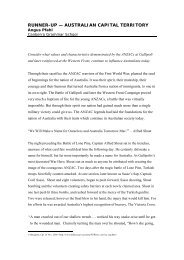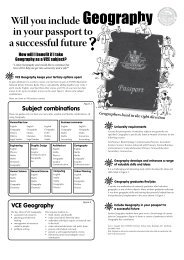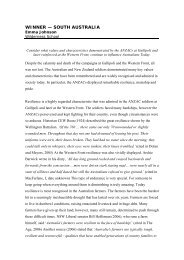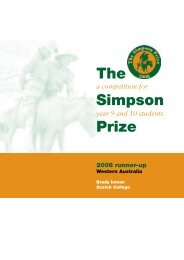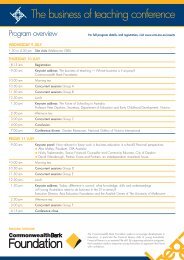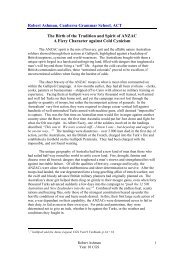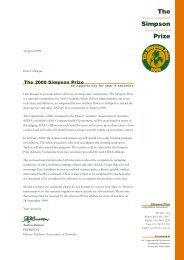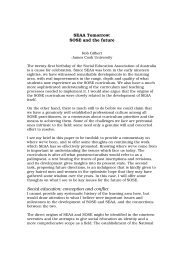Mahesh Umapathysivam - afssse
Mahesh Umapathysivam - afssse
Mahesh Umapathysivam - afssse
Create successful ePaper yourself
Turn your PDF publications into a flip-book with our unique Google optimized e-Paper software.
<strong>Mahesh</strong> <strong>Umapathysivam</strong><br />
Runner-up for South Australia<br />
Prince Alfred College<br />
Are the qualities that make up Anzac Spirit still alive in<br />
society today<br />
On the 25 th of April 1915, the spirit of a nation was born with the landing of the<br />
first Anzac troops. The diggers, as they came to be known, came to symbolise<br />
the qualities that Australians value, and that have become known as the<br />
Anzac sprit – mateship, tenacity, innovation and healthy disrespect for<br />
authority. These are the qualities that have been adopted by people<br />
throughout the nation as defining the Australian Character. They have been<br />
demonstrated many times throughout our short history, especially in times of<br />
crisis and hardship. Their example was the legacy that the Anzac’s left for all<br />
Australians today. It is this challenge that Australians strive to meet.<br />
The young Australian troops that became known as the Anzac’s, showed<br />
intense national pride throughout their time at Gallipoli. This, in itself, is the<br />
nationalism expected of any army fighting for its country. However, it was the<br />
way in which the Anzac’s conducted themselves – their commitment to<br />
mateship, their tenacity in the face of horrible adversity, their bravery and<br />
innovation, that made their place in history and developed a sense of national<br />
character. It is often said that this is when Australia came of age as a nation.<br />
It was not just the soldiers that demonstrated their national pride but also the<br />
civilians back home in Australia and New Zealand. The same national pride is<br />
still apparent eighty-three years later. It was what drove over 60,000<br />
Australian volunteers to give their time and labour to help their country in the<br />
Sydney Olympic games; performing tasks without financial reward – to<br />
contribute to an event of which all Australians could be proud. It is a similar<br />
commitment that drives the army of volunteers who work tirelessly for charity<br />
and community groups. It is in times of need, pain and suffering as well as in<br />
times of joy that Australian’s, who have previously had nothing in common,<br />
<strong>Mahesh</strong> <strong>Umapathysivam</strong>
and together to achieve a common goal for the good of their country and its<br />
international reputation.<br />
The bond between mates is at the very heart of the Anzac tradition and spirit.<br />
Mateship means watching out for, and taking care of your friends, sometimes<br />
at personal cost. John Simpson Kirkpatrick, the soldier with his donkey came<br />
to symbolise this providing an example with which others could identify.<br />
Commitment to helping out those less fortunate is at the core of the Australian<br />
national character. This was apparent in the aftermath of the recent bombing<br />
in Bali. Australians from all walks of life came together to help those affected<br />
by the tragedy. Not only did the Australian Government send specialist<br />
medical and humanitarian teams, but there was also a large contingent of<br />
volunteers who gave their talents and time to help the wounded and the many<br />
people adversely affected. It was not only the people who went to Bali to help<br />
that demonstrated the nation’s capacity to work together to help others, but it<br />
was also the people who organised the fund raising initiatives in Australia that<br />
supported their work. Mateship still means the same thing that it did ninety<br />
years ago; mateship is going above and beyond the call of duty to help<br />
another without regard to the personal cost involved. Beginning with the<br />
Anzacs, this enduring quality is a cornerstone of Australian culture and<br />
society.<br />
During the Anzac’s time at Gallipoli they demonstrated innovation and<br />
endurance. The soldiers were given the name diggers because they dug so<br />
many trenches so quickly at Gallipoli and they kept digging despite the terrible<br />
conditions. The trenches stretched over many miles and were all completed<br />
while under attack from the Turkish troops. The same qualities of tenacity and<br />
innovation have survived to modern day Australians, in the farmers facing<br />
ongoing drought, in whole communities rebuilding after fires and floods. This<br />
is just the kind of tenacity that was showed in Gallipoli ninety years ago as<br />
modern day Australians show time and time again the ability to endure and<br />
fight on through, pain, discomfort and hardship with a little bit of help from<br />
their mates.<br />
<strong>Mahesh</strong> <strong>Umapathysivam</strong>
The Australians at Gallipoli also found resourceful alternatives to the<br />
sometimes dangerous and risky tasks. One such invention was that of the<br />
periscope, which enabled soldiers to see out of the trench while staying safely<br />
hidden. Another famous innovation was the self-shooting guns that enabled<br />
the Australians to successfully retreat without loosing a single soldier. There<br />
are many examples of this innovation and resourcefulness today. Howard<br />
Florey who isolated mould and made it into penicillin made one of the most<br />
notable and important Australian discoveries. Another example is the bionic<br />
ear developed by Professor Graeme Clark in 1983. These innovations helped<br />
to improve the quality of life for many people not only in Australia, but all<br />
around the world.<br />
In World War One the Australian soldiers were just one of many contingents<br />
fighting under the British flag. However, there was something different,<br />
something uniquely Australian about these soldiers. They were not obedient<br />
and restrained soldiers like their British cousins. They did not base their<br />
respect for a person on his rank alone. Australians were not accustomed to<br />
the rigid class based society of Britain. The egalitarian society from which<br />
they came meant that respect had to be earnt and demanded merit. They<br />
also, to the British officers dismay, brought with them their larrikin behaviour<br />
and healthy disregard for the (British) establishment that became the hallmark<br />
of the Australian Character. These characteristics were well known to the<br />
Australians at home; however, the experience of the Anzacs was the first time<br />
that they were on show to the rest of the world.<br />
Australian history is littered with examples with the triumph of the<br />
underdog - Ned Kelly the bushranger who stood up to the authorities, the<br />
miners at the Eureka stockade and the hapless swagman in the folk song<br />
Waltzing Matilda. The Australian public can identify with the character who,<br />
like the Anzacs, “has a go” even when winning seems impossible. It has<br />
something to do with the rascal that all Australians have buried somewhere<br />
inside of them.<br />
<strong>Mahesh</strong> <strong>Umapathysivam</strong>
The Anzac’s assault on the beach at Gallipoli provided a moment in history<br />
that gave generations of Australians inspiration to draw upon. It is a legacy<br />
that underscores the values of mateship, tenacity and innovation. It is this the<br />
first example of the spirit of Australia that all Australians have come to<br />
remember. This spirit is alive and well in the best of endeavours today. These<br />
qualities define what it means to be Australian and they have survived the test<br />
of time and, even though they are not always on show, they seem to emerge<br />
when Australians need them most.<br />
Bibliography<br />
Source: Gallipoli (The book) Written by John Masefield and first published in<br />
September 1916<br />
Source: The ANZAC spirit, created in the year 2000 by “Friends of Auzzie<br />
Slang”<br />
www.aussieslang.com/features/Anzac-spirit.asp<br />
Source: The Rats of Tobruk, Thieves in the night<br />
http://www.convictcreations.com/history/tobruk.htm<br />
<strong>Mahesh</strong> <strong>Umapathysivam</strong>




